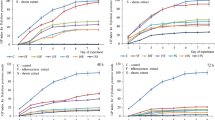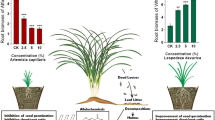Abstract
The growth ofZoysia japonica surroundingAnthoxanthum odoratum onZoysia-grassland in Japan was investigated in June 1994. The stem density ofZ. japonica tended to decrease with short distances between twoA. odoratum plants. This showed that the growth ofZ. japonica surroundingA. odoratum was reduced. Basic, neutral, and acidic fractions extracted fromA. odoratum plants inhibited the seedling growth of lettuce. In particular the neutral fraction showed the strongest activity among the three fractions. The main inhibitory compound obtained atR f 0.6–0.7, on the thin-layer chromatogram of the neutral fraction, was isolated and identified as coumarin by means of GC-MS. Coumarin solution inhibited seedling growth ofZ. japonica in low concentrations but, conversely, promoted seedling growth ofA. odoratum. Coumarin was contained in all parts ofA. odoratum and its concentration varied with the season and from one individual plant to another. In particular, coumarin was highly concentrated in the leaves, accounting for more than 2.5% of dry leaf weight in June. The inhibitory effect of these aqueous extracts was correlated to the amount of coumarin inA. odoratum leaves and cournarin was considered to be the main inhibitory compound.
Similar content being viewed by others
References
Avers, C.J., andGoodwin, R.H. 1956. Studies on roots. 5. Effects of coumarin and scopoletin on the standard root growth pattern ofPhleum pratense.Am. J. Bot. 43:612–620.
Chou, C.H. 1987. The role of allelopathy in agroecosystem: Studies from tropical Taiwan.Ecol. Stud. 78 (Agroecology):104–121.
Chou, C.H., andLee, Y.F. 1991. Allelopathic dominance ofMiscanthus transmorrisonensis in an alpine grassland community in Taiwan.J. Chem. Ecol. 17:2267–2281.
Dornbos, D.L., andSpencer, G.F. 1990. Natural products phytotoxicity. A bioassay suitable for small quantities of slightly water-soluble compounds.J. Chem. Ecol. 16:339–352.
Heisey, R.M., andDelwiche, C.C. 1985. Allelopathic effects ofTrichostema lanceolatum (LABIATAE) in the California annual grassland.J. Ecol. 73:729–742.
Hu, Q.H. 1985. Effect of coumarin on some physiological processes in boron-deficient plants.Plant Physiol. Commun. 6:25–26.
Itow, S. 1975. Succession and structure of grassland vegetation.JIBP Synth. 13:41–45.
Newman, E.I., andMiller, M.H. 1977. Allelopathy among some British grassland species. 2. Influence of root exudates on phosphorus uptake.J. Ecol. 65:399–411.
Newman, E.I., andRovia, A.D. 1975. Allelopathy among some British grassland species.J. Ecol. 63:727–737.
Numata, M. 1975. Primary productivity of semi-natural grasslands and related problems.JIBP Synth. 13:105–110.
Oniki, T., andValio, I.M.F. 1992. Endogenous coumarin and the germination of seeds ofMyroxylon peruiferum L. f. (cabriuva).Revta Brasil. Bot. 15:43–45.
Rice, E.L. 1984. Allelopathy, 2nd ed. Academic Press, New York.
Perez, F.J., andOrmeno-Nunez, J. 1991. Root exudates of wild oats: Allelopathic effect on spring wheat.Phytochemistry 30:2199–2202.
Putnam, A.R. 1988. Allelochemicals from plants as herbicides.Weed Technol. 2:510–518.
Author information
Authors and Affiliations
Rights and permissions
About this article
Cite this article
Yamamoto, Y. Allelopathic potential ofAnthoxanthum odoratum for invadingZoysia-grassland in Japan. J Chem Ecol 21, 1365–1373 (1995). https://doi.org/10.1007/BF02027568
Received:
Accepted:
Issue Date:
DOI: https://doi.org/10.1007/BF02027568




